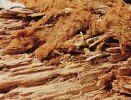Wet RotWet rot is a very common rot, it is a collective name for many types of rot such as cellar fungus Coniophora puteana and mine fungus Fibroporia vaillantii . Wet rot is made up of brown and white rots. The Brown and White definitions are derived from the effect the rot has on the colour of the host timber. Brown rot causes a darkening and White rot has a bleaching effect.
During the building of Victorian houses in heavily populated areas, and in particular Terraced buildings, timbers were often built into the brickwork. Joist ends, wallplates and timber groundings or plugs can be found in most of these buildings. The installed damp proof courses (if any) were partially effective at best and this means that timbers were embedded in damp masonry. These timbers soak up the moisture like a wick and the moisture content of the timber is elevated from the point of contact, gradually decreasing as it evaporates over the increasing distance from that point of contact. Spores of rot of all denominations are carried in the air around us, when these spores come into contact with the damp timber (above 20% w/w) they can germinate and start to grow. As these rots feed from the timber they turn the wood, into simple digestible products. The decay of wood cells by these fungi results in the loss of weight and strength of the wood. Each different rot has its own characteristics, These range from the appearance of the timber to the different fruiting bodies or sporophores (this is the dense growth that produces the spores). It is not possible to know all the different wet rot fungi and also not necessary, as the treatment for wet rots is fairly universal. The correct differentiation of dry rot however, is of paramount importance.Some of the main contributing factors to woodrot are:- moisture levels, temperature, humidity and ventilation (or lack of). Moisture may be introduced by penetrating or rising damp; condensation; building defects and problems such as leaks. Different combinations of moisture, humidity and temperature can have a dramatically different effect on the degradation of the timber concerned, for example, in perfect conditions rot will expand and grow at a far greater rate than in marginal conditions.Wet rot is a reasonably straightforward rot to eradicate and anyone with reasonable DIY skills can tackle this problem. for more details on treatments/course of action, check out our Repair Guide.If you would like a professional opinion, and own your property, you can arrange a free inspection by clicking here.
|
|
Place an advert for your Business on this highly targeted High traffic page Contact For
details |
||||||||||||||
|
Dryspace Maintain |
||||||||||||||
|
|


